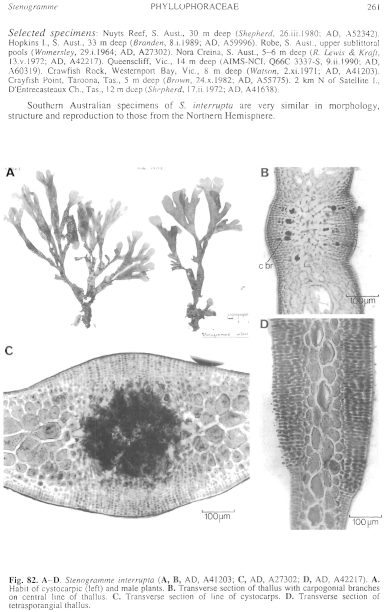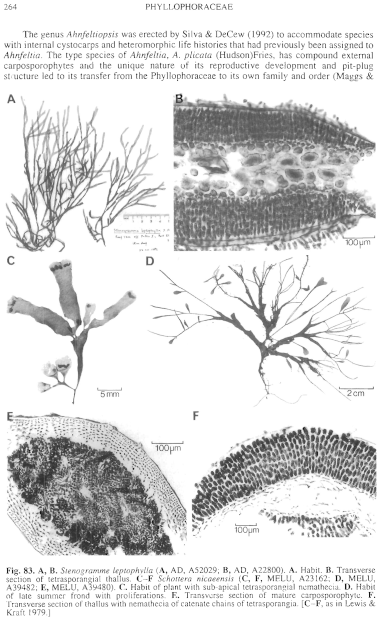|
|
|
|
|
|||||||||||
|
Electronic Flora of South Australia Species Fact Sheet
Phylum Rhodophyta – Class Florideophyceae – Order Gigartinales – Family Phyllophoraceae
Selected citations: J. Agardh 1876: 225; 1885: 32. Chapman 1979: 357, fig. 97. Dixon & Irvine 1977b: 232, fig. 85. Harvey 1859b: 319; 1862: pl. 220. Kützing 1866: 8, pl. 21a-c. Kylin 1928: 52, figs 31,32. Millar 1990: 354, fig. 24A. Schotter 1968: 36, figs 13–19.
Synonym
Delesseria interrupta C. Agardh 1822: 179.
Thallus (Fig. 82A) light to dark red-brown, fading to yellow-grey, 5–15 cm high, complanately and subdichotomously branched at intervals of 1–4 cm, branches flat, (3–) 4–10 (–15) mm broad and 150–400 µm thick, slightly to strongly basally constricted, with rounded axils and apices. Holdfast discoid, 1–8 mm across, with one to several fronds each with a simple or branched slender stipe 2–10 (–20) mm long; epilithic. Structure multiaxial, with a medulla 3–5 cells thick, cells large, ovoid, 60–90 µm diameter, grading into a cortex 2–4 cells thick, outer cells small, ovoid, 4–6 VIM in diameter.
Thallus (Fig. 83A) medium to dark red-brown, fading to light grey-red, 5–20 cm high, more or less complanately and subdichotomously branched at intervals of 0.5–2 (–3) cm, branches flat, 2–3 mm broad, 120–200 µm thick, not or slightly basally constricted, with rounded apices and axils. Holdfast discoid, thin, 2–8 mm across with several to numerous fronds each with a very short compressed stipe 200–300 µm thick; epilithic. Structure multiaxial, with a medulla 2–3 cells thick of large ovoid cells 30–60 µm in diameter, decreasing suddenly to a small-celled cortex 2 (–3) cells thick, outer cells ovoid, 4–6 µm in diameter.
Reproduction: Sexual thalli dioecious. Carpogonial branches (Fig. 82B) numerous, 3–4-celled, situated in the thicker median cortex (10–15 cells thick), each with a large supporting cell which becomes the auxiliary cell. Carposporophytes (Fig. 82C) developing inwardly and in mass forming an interrupted median line, with massed carposporangia each 12–15 µm in diameter, with a pericarp formed by cortical proliferation and an obscure ostiole. Spermatangia in surface sori, cut off from outer cortical cells.
Tetrasporophytes (Fig. 82D) with scattered ovate nemathecia on upper branches, formed by divisions of outer cortical cells giving rows of 4–6 cruciately divided, ovoid tetrasporangia 8–12 µm in diameter, lying within a surface pellicle.
Carpogonial branches 3–4-celled with a large supporting cell, situated on a median line in the thickened cortex. Carposporophytes and spermatangia not seen.
Tetrasporophytes (Fig. 83B) with scattered ovate nemathecia on upper branches with divisions of outer cortical cells forming rows of 5–8 cruciately divided, ovoid to elongate-ovoid, tetrasporangia 8–12 µm in diameter, lying within a surface pellicle.
Type: Type from Cadiz, Spain (Cabrera); lectotype in Herb. Agardh, LD, 24295.
Type from Port Phillip Heads, Vic. (Wilson, 31.i.1880); lectotype in Herb. Agardh, LD, 24313.
Selected specimens: Nuyts Reef, S. Aust., 30 m deep (Shepherd, 26.iii.1980; AD, A52342). Hopkins I., S. Aust., 33 m deep (Branden, 8.i.1989; AD, A59996). Robe, S. Aust., upper sublittoral pools (Womersley, 29.i.1964; AD, A27302). Nora Creina, S. Aust., 5–6 m deep (R. Lewis & Kraft, 13.v.1972; AD, A42217). Queenscliff, Vic., 14 m deep (AIMS-NCI, Q66C 3337-S, 9.ii.1990; AD, A60319). Crawfish Rock, Westernport Bay, Vic., 8 m deep (Watson, 2.xi.1971; AD, A41203). Crayfish Point, Taroona, Tas., 5 m deep (Brown, 24.x.1982; AD, A55775). 2 km N of Satellite I., D'Entrecasteaux Ch., Tas., 12 m deep (Shepherd, 17.ii.1972; AD, A41638). Redcliff Point, N Spencer Gulf, S. Aust., 13 m deep (Shepherd, 9.iv.1980; AD, A51051). 1 km off Pullen I., Port Elliot, S. Aust., 18 m deep (Shepherd, 22.xii.1982; AD, A52029). 24 km SE of Granite I., S. Aust., 36 m deep (Bone, 12.iii.1989; AD, A59696). Margaret Brock reef, Cape Jaffa, S. Aust., 10 m deep (R. Lewis, 15.ii.1974; AD, A45029). Port Phillip, Vic., 14 m deep inside Heads (Womersley, 7.iv.1959; AD, A22800). Norman Bay, Wilsons Prom., Vic., drift (Woodruff, 8.viii.1963; MELU, A1590).
Distribution: Widespread in the cold temperate Northern Hemisphere; New Zealand.
In southern Australia, from Nuyts Reef, S. Aust., to Crawfish Rock, Westernport Bay, Vic., and SE Tasmania; Arrawarra, N.S.W. (Millar 1990, p. 354).
Redcliff Point, N Spencer Gulf, S. Aust., to Wilsons Prom., Vic.
Taxonomic notes: Southern Australian specimens of S. interrupta are very similar in morphology, structure and reproduction to those from the Northern Hemisphere.
2. Stenogramme leptophylla J. Agardh 1885: 32. De Toni 1897: 239.
The above specimens of S. leptophylla are consistently narrower than those of S. interrupta and appear specifically distinct. The structure and reproduction of both species however are very similar.
References:
AGARDH, C.A. (1822). Species Algarum. Vol. 1, Part 2, pp. 169–398. (Berling: Lund.)
AGARDH, J.G. (1876). Species Genera et Ordines Algarum. Vol. 3, Part 1 - Epicrisis systematis Floridearum, pp. i-vii, 1–724. (Weigel: Leipzig.)
AGARDH, J.G. (1885). Till algemes systematik. VII. Florideae. Acta Univ. lund. 21, 1–120, Plate 1.
CHAPMAN, V.J. (1979). The marine algae of New Zealand. Part DI Rhodophyceae. Issue 4: Gigartinales. (Cramer: Germany.)
DE TONI, G.B. (1897). Sylloge Algarum omnium hucusque Cognitarum. Vol. 4. Florideae. Sect. 1, pp. 1–388. (Padua.)
DIXON, P.S. & IRVINE, L.M. (1977b). Seaweeds of the British Isles. Vol. 1, Rhodophyta. Part I, Introduction, Nemaliales, Gigartinales. [British Museum (N.H.): London.]
HARVEY, W.H. (1848). Phycologia Britannica. Plates 145–216. (Reeve: London.)
HARVEY, W.H. (1859b). Algae. In Hooker, J.D., The Botany of the Antarctic Voyage. Flora Tasmaniae. Vol. II, pp. 282–320.
HARVEY, W.H. (1862). Phycologia Australica. Vol. 4, Plates 181–240. (Reeve: London.)
KÜTZING, F.T. (1866). Tabulae Phycologicae. Vol. 16. (Nordhausen.)
KYLIN, H. (1928). Entwicklungsgeschichtliche Florideen Studien. Lunds Univ. Årsskr. N.F. Avd. 2, 24 (4), 1–127.
MILLAR, A.J.K. (1990). Marine Red Algae of the Coffs Harbour Region, northern New South Wales. Aust. Syst. Bot. 3, 293–593.
SCHOTTER, G. (1968). Recherches sur les Phyllophoracees. Bull. Inst. Océanogr. Monaco 67, 1–99.
The Marine Benthic Flora of Southern Australia Part IIIA complete list of references.
Publication:
Womersley, H.B.S. (14 January, 1994)
The Marine Benthic Flora of Southern Australia
Rhodophyta. Part IIIA, Bangiophyceae and Florideophyceae (to Gigartinales)
Reproduced with permission from The Marine Benthic Flora of Southern Australia Part IIIA 1994, by H.B.S. Womersley. Australian Biological Resources Study, Canberra. Copyright Commonwealth of Australia.
Illustrations in Womersley Part IIIA, 1994: FIG. 82 A–D FIG. 83A, B.

Figure 82 enlarge
Fig. 82. A–D. Stenogramme interrupta (A, B, AD, A41203; C, AD, A27302; D, AD, A42217). A. Habit of cystocarpic (left) and male plants. B. Transverse section of thallus with carpogonial branches on central line of thallus. C. Transverse section of line of cystocarps. D. Transverse section of tetrasporangial thallus.

Figure 83 enlarge
Fig. 83. A, B. Stenogramme leptophylla (A, AD, A52029; B, AD, A22800). A. Habit. B. Transverse section of tetrasporangial thallus. C–F Schottera nicaeensis (C, F, MELU, A23162; D, MELU, A39482; E, MELU, A39480). C. Habit of plant with sub-apical tetrasporangial nemathecia. D. Habit of late summer frond with proliferations. E. Transverse section of mature carposporophyte. F. Transverse section of thallus with nemathecia of catenate chains of tetrasporangia. [C–F, as in Lewis & Kraft 1979.]

|
Email Contact: State Herbarium of South Australia |

|